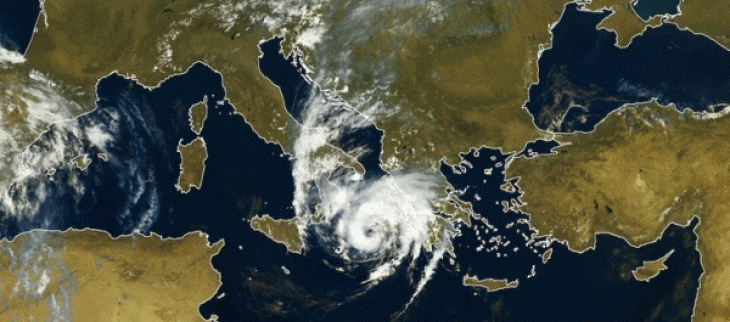THE "MEDICANES" (MEDITERRANEAN HURRICANES) AND CLIMATE CHANGE
Davide Faranda (LSCE-IPSL, CNRS, France), Erika Coppola (ICTP, Italy)
Medicanes are Mediterranean cyclones whose characteristics resemble those of tropical cyclones. They are often associated with hurricane-force winds and heavy precipitation. With a frequency of 1-2 per year, it is a challenge to determine whether their frequency should increase or decrease in a warmer world. Their intensity is however projected to increase due to the warming projections for the Mediterranean sea, the main source of energy for medicanes.
Medicanes are mediterranean cyclones, with properties of both tropical cyclones and mid-latitude frontal depressions. Their genesis is often linked to the arrival of an Atlantic low-pressure system over the Mediterranean and to the presence of a high temperature gradient between the sea and the upper troposphere, which favors convection and thunderstorms around the center of the cyclone. The organization of the convection in concentric storm bands can trigger, with a complex process, the transition from extratropical (cold core) to tropical (warm core) storms. The phenomena associated with medicanes are typical of hurricanes: extreme rainfall and strong winds [1]. The medicanes also have different characteristics from those of tropical cyclones: their size is small and their occurrence is not limited to the fall season: we can have significant temperature gradients between sea and atmosphere at any time, through the effect of the intrusion of Arctic air over the Mediterranean basin.
The preferred area for the genesis of medicanes is the Channel of Sicily: one of the most recent cyclones, Ianos (2020), has rapidly intensified moving to the northeast of the Gulf of Sirte, its place of formation. Ianos reached its maximum intensity near Greece on September 18, 2020 with winds of 120 km/h and heavy rains that caused flooding and quite significant agricultural damage. Cases of medicanes are also documented in French and Spanish regions such as Corsica and Provence, and along the Algerian and Tunisian coasts. On November 4-5, 2011, an extratropical depression named Rolf formed over the Balearic Islands. The continuous thunderstorm systems that developed around the storm caused more than 900 mm of rain to fall in the department of Gard (30) and wind gusts up to 150km/h were recorded in Provence. The medicanes which affect these French regions are not so rare: during the last twenty years there were at least a dozen of them. However, there are exceptional events, such as tropical cyclone Stephanie (September 14-16, 2016), which hit Burgundy and the Basque country with gusts of 135km/h and intense rainfall.
Scientists have recently begun to study the effects of climate change on the characteristics (frequency and intensity) of these storms. This is a difficult problem to address: on the one hand, the climatology of medicanes is only accurately known from the satellite era (about 1975), on the other hand, the modest size of these systems makes it impossible to simulate them in global climate models [3,4]. In regional climate models, it has been shown that an increase of 3°C in sea temperature could lead to the formation of real hurricanes in the Mediterranean, whose frequency and intensity is difficult to estimate. Recently the regional earth system models have been developed and used for the Mediterranean basin within the Med-CORDEX community and based on the literature published we are able to say that for a global warming of 2oC or more the frequency of Medicanes is projected to decrease but their intensity is projected to increase[6,7]. The decrease in frequency comes from the more anticyclonic conditions in the Mediterranean basin, which should reduce the cyclogenesis in the basin. The increase in intensity is linked to the warming of the Mediterranean basin, the major source of energy uptake for medicanes. New regional coupled experiments are planned within the Med-CORDEX (https://www.medcordex.eu/) community to produce an ensemble of simulations to improve the understanding of the climate change impact on this kind of storms.
A parallel line of research on medicanes is to attribute their characteristics to climate change. In [8], the authors analyzed the role of climate change in the triggering of medicane Apollo, which hit Sicily in October 2021, causing flooding. The analysis highlights that the cyclone is unprecedented and that similar storms over Sicily, although less intense, tend to occur more frequently in September in the current climate (1992-2021), the warmest for the Mediterranean Sea, compared to a climate less affected by climate change (1950-1979). The occurrence of these cyclones in September increases the risk of intense precipitation and therefore the socio-economic impacts on the population.

Figure 1. Medicane Ianos, satellite image, source: meteofrance
References
[1] Daniele Bianchino, private communications and website : http://medicanes.altervista.org/
[2] Cavicchia, L.; von Storch, H.; Gualdi, S. (2014). “A long-term climatology of medicanes”. Climate Dynamics. 43 (5–6): 1183–1195.
[3] Cioni, G., Cerrai, D., & Klocke, D. (2018). Investigating the predictability of a Mediterranean tropical-like cyclone using a storm-resolving model. Quarterly Journal of the Royal Meteorological Society, 144(714), 1598-1610.
[4] Davolio, S.; Miglietta, M.M.; Moscatello, A.; Pacifico, A.; Buzzi, A.; Rotunno, R. (2009). “Numerical forecast and analysis of a tropical-like cyclone in the Ionian Sea” Natural Hazards and Earth System Sciences.. 9 (2): 551–562.
[5] Gaertner, M.A.; Jacob, D.; Gil, V.; Domínguez, M.; Padorno, E.; Sánchez, E.; Castro, M. (2007). “Tropical cyclones over the Mediterranean Sea in climate change simulations”. Geophysical Research Letters 34 (14): L14711
[6]Ranasinghe, R., A.C. Ruane, R. Vautard, N. Arnell, E. Coppola, F.A. Cruz, S. Dessai, A.S. Islam, M. Rahimi, D. Ruiz Carrascal, J. Sillmann, M.B. Sylla, C. Tebaldi, W. Wang, and R. Zaaboul, 2021: Climate Change Information for Regional Impact and for Risk Assessment. In Climate Change 2021: The Physical Science Basis. Contribution of Working Group I to the Sixth Assessment Report of the Intergovernmental Panel on Climate Change [Masson-Delmotte, V., P. Zhai, A. Pirani, S.L. Connors, C. Péan, S. Berger, N. Caud, Y. Chen, L. Goldfarb, M.I. Gomis, M. Huang, K. Leitzell, E. Lonnoy, J.B.R. Matthews, T.K. Maycock, T. Waterfield, O. Yelekçi, R. Yu, and B. Zhou (eds.)]. Cambridge University Press, Cambridge, United Kingdom and New York, NY, USA, pp. 1767–1926, doi:10.1017/9781009157896.014.
[7] Reale, M., Cabos Narvaez, W.D., Cavicchia, L. et al. Future projections of Mediterranean cyclone characteristics using the Med-CORDEX ensemble of coupled regional climate system models. Clim Dyn 58, 2501–2524 (2022). https://doi.org/10.1007/s00382-021-06018-x
[8] Faranda, D., Bourdin, S., Ginesta, M., Krouma, M., Messori, G., Noyelle, R., Pons, F., and Yiou, P.: A climate-change attribution retrospective of some impactful weather extremes of 2021, Weather Clim. Dynam. [in press, accepted version available here: https://hal.archives-ouvertes.fr/hal-03558636].
 This project has received funding from the European Union’s Horizon 2020 research and innovation programme under grant agreement No 101003469.
This project has received funding from the European Union’s Horizon 2020 research and innovation programme under grant agreement No 101003469.



